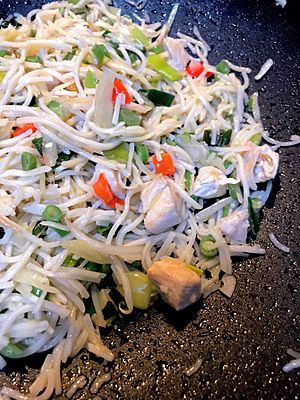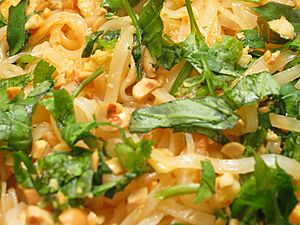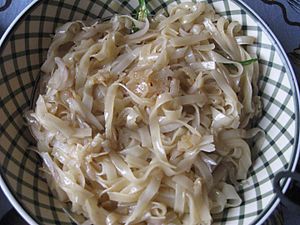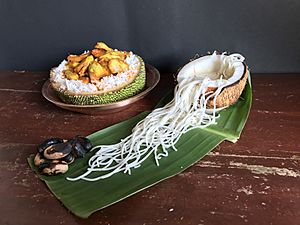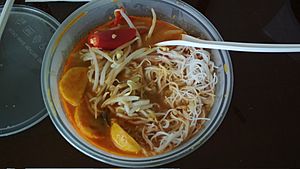Rice noodles facts for kids
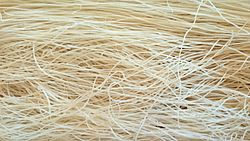
Thin rice noodles in dried form
|
|
| Type | Noodle |
|---|---|
| Place of origin | China |
| Region or state | East Asia and Southeast Asia |
| Main ingredients | Rice flour, water |
| Variations | Bánh canh, bánh phở, khanom chin, kuān tiáo, lai fun, mixian, rice vermicelli, sevai, shahe fen |
Rice noodles are a type of noodle made mainly from rice flour and water. Sometimes, other ingredients like tapioca or corn starch are added. These extra ingredients can make the noodles clearer or give them a chewier texture.
Rice noodles are very popular in the foods of East Asia and Southeast Asia. You can find them fresh, frozen, or dried. They come in many different shapes, thicknesses, and textures. Fresh noodles don't last long, usually only a few days.
Contents
History of Rice Noodles
The story of rice noodles began in China during the Qin dynasty. This was when people from northern China moved south. In the north, people traditionally ate wheat and millet because these grains grew well in cold weather. In the south, rice was the main crop because it grew in hot weather.
Noodles were usually made from wheat in northern China. To adapt to the south, northern cooks tried making "noodles" using rice flour. This is how rice noodles were first invented! Over time, rice noodles and the ways to make them spread around the world. They became especially popular in Southeast Asia. In India, a similar dish called idi-appam (strings of cooked rice) was known around the 1st century AD.
Drying rice noodles helps them last much longer. This removes the water, which stops them from spoiling quickly.
Different Kinds of Rice Noodles
Rice noodles come in many shapes and sizes, each used for different dishes.
Round Thick Noodles
- Bánh canh are thick Vietnamese noodles. The word bánh means something made from flour, and canh means "soup."
- Lai fun are short, thick Chinese noodles. They are sometimes called bánh canh by Vietnamese people.
- Silver needle noodles are short Chinese noodles, about 5 cm long. They are thicker in the middle and get thinner at the ends, like a rat's tail. People in Malaysia and Singapore sometimes call them "rat noodles" or "mouse tail noodles."
Flat Thick Noodles
- Bánh phở are thick, dried rice noodles. They are famous in Vietnamese beef noodle soups, like phở.
- Shahe fen (also known as chow fun or ho fun) are wide Chinese noodles. They are often used in stir-fried dishes.
- Sen lek are narrow, flat rice noodles from Thailand. They are used in popular dishes like pad thai and noodle soups.
Thin Noodles
- Khanom chin are fresh, thin rice noodles from Thai cooking. They are made by fermenting rice for a few days, boiling it, and then pressing the dough through a sieve into hot water.
- Rice vermicelli are very thin strips of rice noodles. They are sometimes called "rice sticks" or bí-hún in different places.
Other Varieties
- Mixian is a type of rice noodle from Yunnan Province, China. It is made from regular rice. You can find it in two main thicknesses: a thinner form (about 1.5 mm wide) and a thicker form (about 3.5–4 mm wide).
Dishes Made with Rice Noodles
Rice noodles are used in countless delicious dishes across Asia and beyond. Here are some examples:
Burmese Dishes
- Mohinga is a popular Burmese fish noodle soup. It is often eaten for breakfast.
- Shan khauk swè are thin noodles served with a peppery soup. They are topped with chicken or pork and pickled vegetables.
Cambodian Dishes
- Kuyteav is a Cambodian noodle soup. It is made with pork broth and various toppings.
- Num banhchok is a traditional Cambodian breakfast dish. It features rice vermicelli with a fish-based green curry gravy.
Chinese Dishes
- Beef chow fun is a classic Cantonese dish. It has stir-fried wide rice noodles with beef and vegetables.
- Crossing-the-bridge noodles is a famous noodle soup from Yunnan, China. It is known for its many separate ingredients that are added to a hot broth at the table.
- Luosifen is a unique noodle soup from Guangxi, China. It is known for its strong, savory, and slightly sour flavor, often including pickled bamboo shoots.
Filipino Dishes
- Pancit bihon is a popular Filipino stir-fried noodle dish. It uses thin rice noodles with vegetables and meat.
- Pancit palabok is another Filipino noodle dish. It has rice noodles covered in a thick, shrimp-flavored sauce and various toppings.
Indonesian Dishes
- Bihun goreng is Indonesian fried rice vermicelli. It is stir-fried with sweet soy sauce, vegetables, and meat.
- Kwetiau goreng is Indonesian fried flat rice noodles. It is similar to bihun goreng but uses wider noodles.
Lao Dishes
- Khao poon is a spicy Lao noodle soup. It is made with fermented rice vermicelli, coconut milk, and various meats.
- Khua mee is a savory, sweet, and caramelized fried noodle dish from Laos. It is often topped with a fried egg omelette.
Malaysian Dishes
- Char kway teow is a famous Malaysian stir-fried noodle dish. It features flat rice noodles, shrimp, cockles, bean sprouts, and chives.
- Laksa is a spicy noodle soup popular in Malaysia. It comes in many regional varieties, often with coconut milk or a sour fish broth.
South Indian / Sri Lankan Dishes
- String Hopper or Idiyappam are steamed rice noodle cakes. They are popular in South India and Sri Lanka, often served with curries.
Singaporean Dishes
- Hokkien mee is a stir-fried noodle dish. It combines yellow noodles and rice vermicelli with seafood and pork.
- Satay bee hoon is a unique Singaporean dish. It features rice vermicelli topped with a rich, peanut-based satay sauce and various ingredients.
Thai Dishes
- Pad thai is one of Thailand's most famous dishes. It is a stir-fried rice noodle dish with eggs, tofu, shrimp or chicken, peanuts, and lime.
- Phat si-io is another popular Thai stir-fried noodle dish. It uses wide rice noodles with dark soy sauce, Chinese broccoli, and meat.
- Kuaitiao ruea are a type of Thai noodle soup. They are known for their rich, dark broth, often made with pig or cow blood.
Vietnamese Dishes
- Bún bò Huế is a spicy Vietnamese beef noodle soup. It is known for its rich, flavorful broth with lemongrass.
- Phở is perhaps the most famous Vietnamese noodle soup. It features clear broth, rice noodles, herbs, and meat (usually beef or chicken).
- Gỏi cuốn (also known as Summer roll) are fresh spring rolls. They are made with rice vermicelli, shrimp, pork, and vegetables wrapped in rice paper.
See also
 In Spanish: Fideo de arroz para niños
In Spanish: Fideo de arroz para niños


